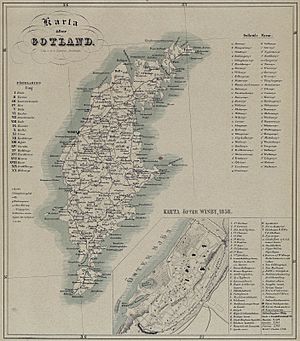Russian occupation of Gotland facts for kids
Quick facts for kids Occupation of Gotland |
|||||||
|---|---|---|---|---|---|---|---|
| Part of the Finnish War (Napoleonic Wars) | |||||||
 1858 map of Gotland |
|||||||
|
|||||||
| Belligerents | |||||||
| Commanders and leaders | |||||||
| Strength | |||||||
| 2,000 | 1,800 | ||||||
| Casualties and losses | |||||||
| 1 dead | 1,800 surrendered | ||||||
The Russian occupation of Gotland took place in April and May 1808. This event was part of the Finnish War, a larger conflict between Sweden and Russia. During this time, Russian forces landed on the Swedish island of Gotland and took control for a short period. However, Swedish forces quickly arrived and made the Russians surrender.
Contents
What Happened on Gotland?
Russia had invaded Finland on February 21, 1808. A group of nine Russian merchant ships left Liepāja (a city in modern-day Latvia). They landed on Gotland on April 22, 1808. They had lost their way because of thick fog.
The Russian force landed at Slesviken in Grötlingbo, in southern Gotland. They had 1,800 soldiers and six artillery guns. Their leader was Admiral Nikolai Bodisko.
At first, people on Gotland were confused. But soon, beacons (signal fires) were lit to warn everyone about the invasion. The alarm reached the local governor, Erik af Klint. He was a retired navy officer. Af Klint began to gather a fighting force on Gotland, following orders from Stockholm, the capital of Sweden.
Gotland's Defense
Gotland did not have any regular soldiers ready when the Russians invaded. So, Erik af Klint had to create a peasant levy. This meant he gathered local farmers and civilians to fight.
This local force met the Russian soldiers near Klinte Church. Af Klint realized that his small, untrained force could not win. He decided to surrender without a fight. The surrender happened on April 23, 1808, at an inn in Sanda.
The next day, the Russian army marched into Visby, the main town on Gotland. They set up their headquarters there. Admiral Bodisko declared himself the new governor of Gotland. However, he allowed most Swedish officials to keep their jobs, except for Erik af Klint.
Sweden's Response
Sweden quickly sent help to Gotland. Two Swedish warships, Tapperheten and Manligheten, sailed from Karlskrona. They arrived on May 12 and blockaded the harbor of Slite. This stopped any more Russian ships or supplies from reaching Gotland.
A larger Swedish relief group was sent on May 11. It was led by Admiral Rudolf Cederström. This group included several large warships like Konung Gustav IV Adolph and Äran. It also had a frigate (a fast warship), two brigantines (small sailing ships), and a yacht.
On board these ships were more than two thousand soldiers from Småland. They were led by Lieutenant-Colonel Carl Johan Fleetwood.
Russian Surrender
When the news reached Visby that Swedish forces were on Gotland, the Russians gave up. The Swedish fleet had arrived at Sandviken on May 14. The Swedish soldiers then marched to Tule in Ganthem.
The Russians left Visby on May 17. They sailed away from Gotland through Slite the next day. The occupation was over.
Losses
Only one person died during the Russian occupation of Gotland. He was a Swedish sailor named Carl Fredrik Lindgren (1777–1808). He fell from the rigging of the flagship, Konung Gustav IV Adolph, at Sandviken. He was buried at Syssne udd.
Aftermath
After the occupation, the Russian commander, Nikolai Bodisko, faced a court-martial. This is a military trial. He lost his job, but he later got it back.
In Sweden, this event led to a big change. It helped create a system of national conscription. This meant that all citizens could be called to serve in the military. The Gotland National Conscription was the first unit formed under this new system in 1811.
See also
- Gotland National Conscription
Sources
- Ingemund Hägg: Graven på Sysneudd, 2013
- Gunnar Unger: Illustrerad svensk sjökrigshistoria: afsedd för undervisningen vid k. sjökrigsskolan. Del 1, omfattande tiden intill 1680, Bonniers, Stockholm 1909, pp 228-32
- Mika Koskelainen: I spåren efter den ryska invasionen av Gotland 1808 på Sveriges Radios webbplats 22 mars 2008, viewed 2014-08-28

